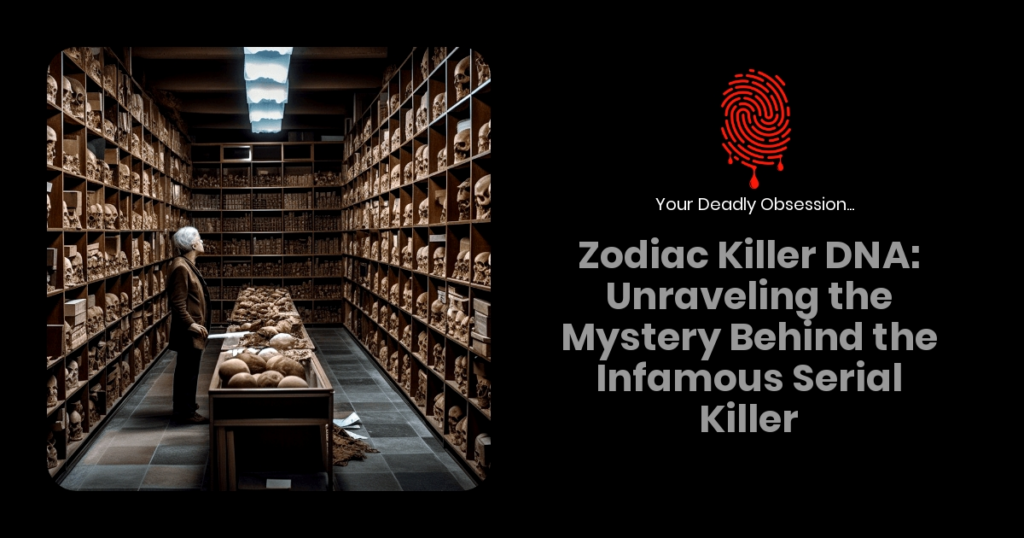For decades, zodiac killer DNA has remained shrouded in mystery, keeping investigators and enthusiasts alike in a continued state of curiosity. Emerging in the late 1960s, the Zodiac Killer left a trail of death and unsettling coded messages in his wake. Due to the case’s complex nature, it has been incredibly difficult for authorities to pinpoint the killer’s true identity, though recent advancements in DNA forensics have led to new potential breakthroughs in the investigation.

We’re always intrigued by true crime history, and the Zodiac Killer story is a prime example of an unsolved mystery that persists to this day. Since the inception of forensic science, DNA analysis has come a long way, providing helpful insights into criminal investigations. In an effort to unmask the Zodiac Killer, investigators have been tirelessly scouring through genealogy databases and old evidence, hoping to find a DNA match that could finally put an end to the case.
Although significant progress has been made towards identifying the elusive figure behind the Zodiac killings, the final answer remains uncertain. Regardless of the outcome, the significance of DNA in solving these types of infamous crime cases cannot be understated. As more technological advancements are made in the field of forensic science, the chances of uncovering the truth behind such mysteries grow stronger.
The Zodiac Killer: A Brief Overview
We’ll start by taking a quick look at who the Zodiac Killer was and why this case is so captivating. Active during the late 1960s and early 1970s, the Zodiac Killer is believed to have murdered at least five people in Northern California. What sets this case apart from others is the cryptic messages and letters the killer sent to newspapers and law enforcement agencies, adding an air of mystery that continues to intrigue us even today.
The victims of the Zodiac Killer include:
- David Faraday and Betty Lou Jensen, killed on December 20, 1968
- Darlene Ferrin, killed on July 4, 1969
- Cecelia Shepard, killed on September 27, 1969
- Paul Stine, killed on October 11, 1969
The Zodiac Killer’s cryptic messages were, and still are, a considerable part of this case. The killer sent taunting, encrypted messages, bragging about the killings and challenging authorities to decipher them. Out of the four ciphers sent by the Zodiac Killer, only one has been definitively solved so far. The unsolved ciphers, some believe, may hold critical information regarding the killer’s identity.
Given the limited technology of the time and the mysterious nature of the case, the Zodiac Killer managed to avoid capture. Over the years, there have been numerous suspects, but none of them could be definitively linked to the murders. The case remains open, and the search for the Zodiac Killer’s identity persists.
Nowadays, DNA technology has significantly advanced and could potentially help solve the case. In recent years, the Golden State Killer’s arrest – another infamous, previously unsolved case – has reignited hope in identifying the Zodiac Killer through similar methods. The use of familial DNA and forensic genealogy might be the key to unlocking the identity of the Zodiac Killer.
In summary, the Zodiac Killer remains an enduring topic of fascination due to the mysterious nature of the crimes, the cryptic messages, and the unknown identity of the killer. The possibility of using advanced DNA technology to finally solve this case keeps the Zodiac Killer at the forefront of cold case investigations, engaging die-hard fans of crime and mystery.
Unraveling the Mystery with DNA Evidence
As one of the most notorious cold cases in American history, the Zodiac Killer has left law enforcement and mystery enthusiasts searching for answers for decades. It’s the advancements in DNA technology that may finally provide the key to unlocking this case.
The role of DNA evidence in this investigation can’t be understated. We’re already aware that the Zodiac Killer left traces of DNA on some of the crime scene evidence, including stamps and envelopes from letters sent to the media. With new DNA analysis techniques, we have the opportunity to reveal previously undiscovered clues that could potentially identify the Zodiac Killer.
Modern advancements in DNA analysis include:
- Whole Genome Sequencing: This technology allows us to sequence and analyze each part of a person’s DNA, providing detailed information about their genetic makeup.
- Genealogical Research: By researching family trees, we can trace lineages and find distant relatives, potentially leading to the discovery of the Zodiac Killer’s true identity.
- DNA Databases: As more people submit their DNA to databases such as AncestryDNA, 23andMe, and GEDmatch, we have a larger pool of potential matches, increasing the likelihood of finding the Zodiac Killer’s DNA in the system.
With these tools at our disposal, investigators are hard at work analyzing and comparing DNA samples collected from the crime scenes to potential matches in the aforementioned databases. The use of genealogical research has already led to identification of criminals in other cold cases, such as the Golden State Killer, which gives us hope for a breakthrough in the Zodiac case as well.
However, challenges are still present in the quest to uncover the Zodiac Killer’s identity through DNA evidence. First, the age of the samples poses a concern – the degradation of DNA over time can make it difficult to obtain a reliable profile. Second, the risk of contamination is something we must consider, since the handling and storage of evidence in the 1960s and 1970s did not follow today’s stringent standards.
Despite these obstacles, we believe that DNA evidence holds the key to unlocking the mystery surrounding the Zodiac Killer. As technology continues to advance and more people contribute to DNA databases, it’s only a matter of time before we may finally unmask the infamous Zodiac Killer.
Collecting and Analyzing Zodiac Killer DNA Samples
When it comes to cold cases, crime, and mystery, few are more baffling than the activities of the Zodiac Killer. To help identify this enigmatic figure, DNA samples play a crucial role. In this section, we’ll discuss how DNA samples are collected and analyzed in attempts to unveil the Zodiac Killer’s identity.
Collection Methods
Collecting DNA evidence tied to the Zodiac Killer is a complex process. Over the years, several innovative methods have been employed, including:
- Cigarette butts: Detectives have combed through crime scenes for discarded cigarette butts that may contain the killer’s saliva.
- Stamp and envelope glue: Letters sent by the Zodiac Killer to newspapers and police often had stamps licked and glued by the sender, potentially affording remnants of DNA.
- Clothing: Items believed to belong to the Zodiac Killer, such as gloves and scarves, are another potential source of genetic material.
DNA Sample Analysis
DNA analysis in the Zodiac Killer case primarily falls into two categories:
- Forensic DNA Testing: Advanced techniques, such as PCR (Polymerase Chain Reaction) and STR (Short Tandem Repeats), are employed to scrutinize the genetic material extracted from collected samples. These methods allow scientists to develop unique profiles based on small amounts of DNA.
- Genetic Genealogy: By cross-checking the Zodiac Killer’s DNA against existing databases, analysts can identify potential family connections. This process narrows down the pool of suspects and aids in zeroing in on the killer’s identity.
Challenges and Limitations
As we explore the world of Zodiac Killer DNA analysis, it’s crucial to discuss the challenges and limitations faced. Factors that hinder progress include:
- Degraded DNA: Given the age of the evidence, most samples harbor degraded DNA, making it challenging for analysts to develop a complete profile.
- Contamination: The risk of samples being contaminated during collection or storage can hamper the pursuit of accurate results.
- Lack of direct DNA evidence: Despite extensive investigation, no direct DNA samples (blood, hair, etc.) have been conclusively linked to the Zodiac Killer.
In the search of the notorious Zodiac Killer, our hopes rest on advancements in DNA technology to help reveal the identity behind the infamous crimes. As science continues to evolve, so does our ability to conquer the maze of this cryptic case.
Challenges and Ethics Surrounding DNA Investigations
When dealing with zodiac killer DNA, it’s important to address the various challenges and ethical concerns surrounding DNA investigations. As promising as these forensic methods can be in solving cold cases, drawbacks and potential controversies must be considered.
Firstly, sample degradation poses a significant hurdle. Decades-old samples, like those from the Zodiac Killer case, may have deteriorated over time, leading to incomplete or unreliable DNA profiles. This can make it difficult to match samples to a suspect or create a clear genetic profile to aid the investigation.
Moreover, the privacy and consent of individuals become central ethical issues. DNA databases are an excellent resource for investigators, but the use of these databases raises concerns about:
- Informed consent: Are individuals aware their DNA information is being used for criminal investigations?
- Privacy intrusion: When DNA samples are collected from crime scenes, are the rights of innocent individuals being respected?
In the same vein, familial searching can cause ethical dilemmas. This method involves searching DNA databases for partial matches to identify relatives of a potential suspect. However, this raises the question of whether it’s fair to involve family members who may not be aware their DNA information is being used in a criminal case.
Additionally, false matches are an ever-present challenge in DNA investigations. Even with advancements in technology, there is still the potential for errors or inaccuracies that can lead to false accusations or wrongful arrests.
Despite these challenges, DNA technology has proven to be a powerful tool in solving cold cases, such as the Golden State Killer. However, it’s crucial to weigh the benefits against potential ethical issues and challenges. The public and law enforcement must work together to strike a balance that respects individual privacy and rights while utilizing the incredible potential of DNA technology to bring closure to unsolved cases.
What is the Zodiac Killer’s real name?

The Zodiac Killer’s real name remains unknown. Despite extensive investigations and numerous suspects, the killer’s identity has never been conclusively determined.
Conclusion: The Role of DNA in Solving the Zodiac Killer Case
The role of DNA in solving the Zodiac Killer case is undoubtedly significant. As advancements in technology continue to grow, we remain hopeful that DNA evidence might finally bring closure to one of the most notorious unsolved serial killings of the 20th century. Below, we’ll outline the potential impacts of DNA in this case, and why it’s still a vital tool in the ongoing investigation.
- Identifying the culprit: DNA evidence has the potential to unmask the true identity of the Zodiac Killer, putting an end to decades of speculation and sensationalism. Genetic material left behind in letters or other physical evidence could be used to create a profile, which could then be matched to a suspect or a relative.
- Verification of claims: Throughout the years, several individuals have claimed to be the Zodiac Killer or were implicated by others. DNA evidence could either corroborate or disprove these claims, allowing law enforcement to focus their efforts on the most likely suspects.
- Possible exoneration: Should the Zodiac Killer’s DNA be identified, it’s possible that individuals previously thought to be involved in the crimes could finally be cleared. This not only restores their reputation, but also allows them to move on from years – if not decades – of suspicion and scrutiny.
- Closure for victims’ families and general public: The apprehension and identification of the Zodiac Killer would no doubt bring closure to the families of the victims, as well as the public who has watched this case unfold for generations. Knowing that the person responsible is no longer free could provide some measure of comfort and healing.
In conclusion, DNA evidence has the potential to play a pivotal role in the Zodiac Killer case. We believe that by leveraging advancements in forensic technology, there’s a real possibility of finally solving this long-standing mystery. Time and continued research will tell if the vital clue needed to crack the Zodiac Killer case will come from DNA, but our persistent hope and fascination ensure that this case will never be forgotten.
References:

Owner & entrepreneur with a passion for murder mystery! Seriously, who doesn’t love murder mystery?
Chris is a proud member of the American Medical Writer’s Association (AMWA), the International Society for Medical Publication Professionals (ISMPP), the National Association of Science Writers (NASW), the Council of Science Editors, the Author’s Guild, and the Editorial Freelance Association (EFA).

